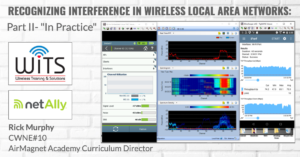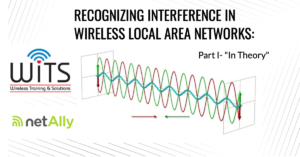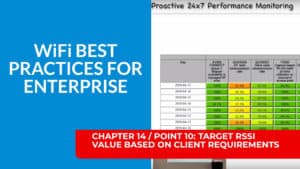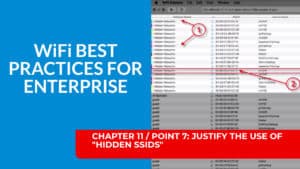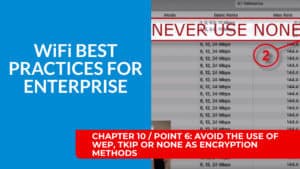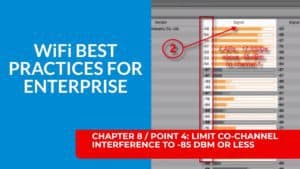During our Workshop: OPTIMIZE YOUR HOME NETWORK FOR WORKING FROM HOME I walked through our Wi-Fi 10 Best Practices with three of the most popular scanning tools: Adrian Granados’ Wi-Fi Explorer, MetaGeek’s inSSIDer Windows, and NetAlly’s AirCheck G 2 to show you how to evaluate and optimize your own home wireless LAN! In case you missed […]
RECOGNIZING INTERFERENCE IN WIRELESS LOCAL AREA NETWORKS: Part II- “In Practice”
In Part II of our Interference webinar series with NetAlly, we put the theory from Part I in to practice with NetAlly’s AirCheck G2, Spectrum XT, and Etherscope nXG! In case you missed it or would like a replay, the webinar recording can be found below. Please let us know if you have any questions. As always, […]
RECOGNIZING INTERFERENCE IN WIRELESS LOCAL AREA NETWORKS: Part I- “In Theory”
In Part I of our Interference webinar series with NetAlly, we defined the types of interference and used hand-crafted, interactive visuals to demonstrate the effects of interference in wireless local area networks (WLANS). You don’t want to miss Part II where we’ll will put the THEORY from Part I in to PRACTICE! Part II- “In Practice” Wednesday, […]
Future-Fi – The Road to 802.11-2020 and Beyond: Chapter 5
By Rick Murphy With important details from the upcoming Report and Order as posted in FCC-CIRC2004-1. In October 2018, I first reported that the FCC was considering opening the 6 GHz band for unlicensed usage by way of Notice of Proposed Rulemaking (NPRM) 19-138, in Future-Fi, Chapter 2. In addition, I shared evidence that the […]
WiTS Debuts Partnership with Andrew von Nagy
Two industry respected powerhouses join forces to expand WiTS professional services portfolio. Colorado Wi-Fi Industry leader, Wireless Training & Solutions, announced today the addition of Andrew von Nagy to the WiTS family of WLAN SMEs. Customer’s critical reliance on wireless connectivity and the resulting increased demands for WLAN Administrators and Technologists are the motivating factors […]
Future-Fi – The Road to 802.11-2020 and Beyond: Chapter 4
Chapter 4: 802.11 is a RAT International Mobile Telecommunications – Next Generation New Year Report – 2019 The countdown has begun. The ball is dropping. In about a year, the newest versions of 802.11 and 5th generation cellular technologies will emerge. As network architects and engineers, it’s important for us to understand the strengths, weaknesses, […]
Future-Fi – The Road to 802.11-2020 and Beyond: Chapter 3
Chapter 3: What’s Next, After AX? That snappy new hybrid we call 802.11ax hasn’t even left its garage yet and already the 802.11 Working Group is planning a replacement model. In this chapter of “Future-Fi” we’ll look at the current Task Groups, Study Groups, and one Topic Interest Group that are actively working towards […]
Future-Fi – The Road to 802.11-2020 and Beyond: Chapter 2
Chapter 2: 802.11ax Operations in 6 GHz Up the Revolution! The revolution starts October 23rd! Are you ready for the biggest change to affect the soul of Wi-Fi since 802.11a expanded into the 5 GHz band, in 1999? History is about to repeat; that is, if the FCC keeps Chairman Ajit Pai’s […]
Future-Fi – The Road to 802.11-2020 and Beyond: Chapter 1
Chapter 1: Understanding the IEEE 802 Standards Development Life Cycle: The future of Wi-Fi is so bright you’ll need an arc welder’s helmet to look directly at the new capabilities under development in the 802.11 Working Group, such as; Possibility of up to 64 additional non-overlapping 20 MHz-wide channels in 6 GHz band […]
WiFi Best Practices for Enterprise / Chapter 14 – #10 Target RSSI Value Based on Client Requirements
WiFi Best Practices for Enterprise / Chapter 14 – #10 Target RSSI Value Based on Client Requirements PREVIOUS CHAPTER: Chapter 13
WiFi Best Practices for Enterprise / Chapter 13 – #9 Use Only Channels 1, 6 and 11 in 2.4GHz
To get the most out of the 2.4GHz band and avoid adjacent-channel interference, you should only use Channels 1, 6 and 11. PREVIOUS CHAPTER: Chapter 12 NEXT CHAPTER: Chapter 14
WiFi Best Practices for Enterprise / Chapter 12 – #8 Disable 802.11b Rates Unless Required
Management traffic traffic travels at the slowest basic rate available. Eliminating the slowest basic rates can speed up this traffic, allowing more time for data to be sent. Rick explains how this can be done and why you may not want to. PREVIOUS CHAPTER: Chapter 11 NEXT CHAPTER: Chapter 13
WiFi Best Practices for Enterprise / Chapter 11 – #7 Justify the Use of Hidden SSIDs
“hidden SSIDs” were developed as a mechanism to enhance security. It failed. Rick explains why. PREVIOUS CHAPTER: Chapter 10 NEXT CHAPTER: Chapter 12
WiFi Best Practices for Enterprise / Chapter 10 – #6 Avoid the Use of WEP, TKIP or None
WEP, TKIP and None have been found to be poor encryption methods. Rick explains why here. PREVIOUS CHAPTER: Chapter 9 NEXT CHAPTER: Chapter 11
WiFi Best Practices for Enterprise / Chapter 9 – #5 Limit the Number of SSIDs per Radio
Limiting the number of SSIDs can drastically reduce the amount of overhead traffic being transmitted. PREVIOUS CHAPTER: Chapter 8 NEXT CHAPTER: Chapter 10
WiFi Best Practices for Enterprise / Chapter 8 – #7 Limit Co-Channel Interference
Co-channel interference and adjacent-channel interference are covered in this section. PREVIOUS CHAPTER: Chapter 7 NEXT CHAPTER: Chapter 9

